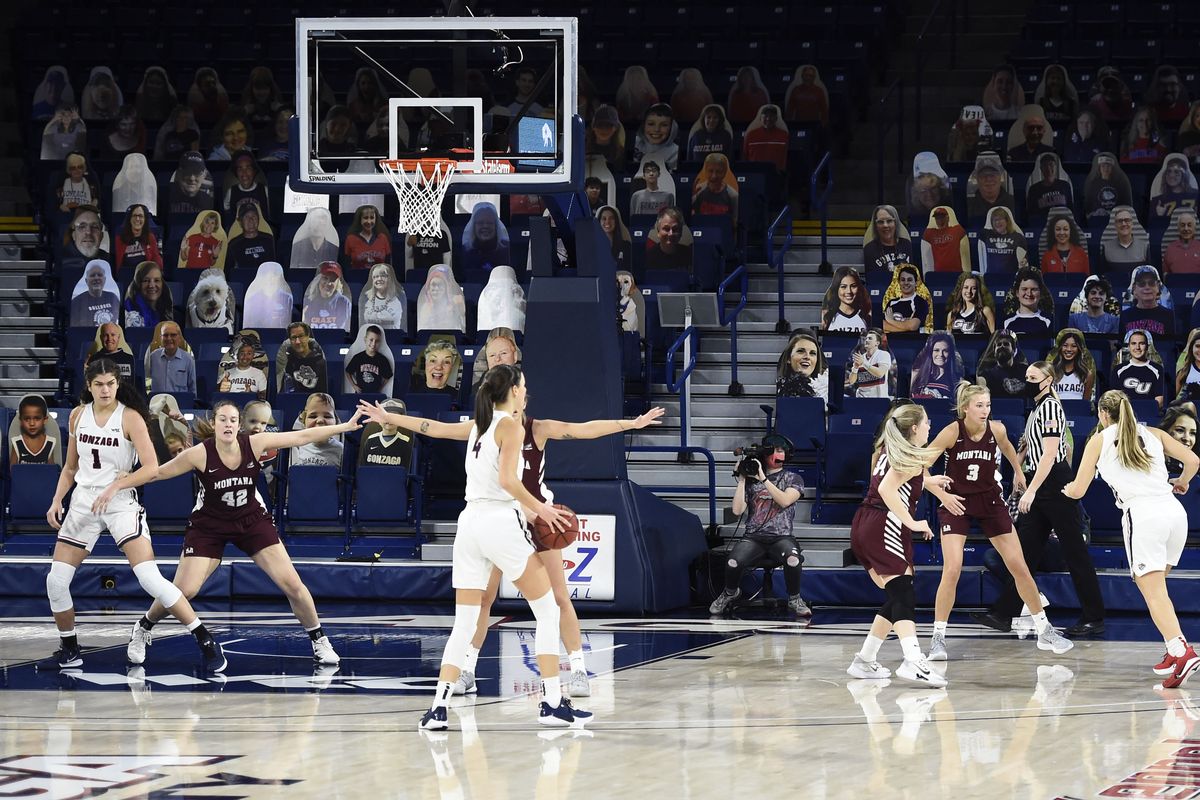‘How weird is that?’ AD Mike Roth stays upbeat watching Gonzaga’s first COVID-era home sporting event

Standing in a barren concourse at the McCarthey Athletic Center on Sunday afternoon, Gonzaga athletic director Mike Roth tried to savor the moment.
That wasn’t easy, even for Roth, whose enthusiasm for GU is downright infectious, though no one is using that adjective these days.
Down on the Kennel floor, bouncing basketballs echoed through the empty building as the Gonzaga women warmed up for their game against Montana.
It was the home opener not only for women’s basketball, but for everyone at Gonzaga.
“I don’t know if everybody realizes it, but this is our first event of the year,” said Roth, offering condolences to the lost seasons of GU’s volleyball, soccer and cross country athletes.
“How weird is that?” Roth asked.
By the standards of COVID-era intercollegiate athletics, not that weird.
Instead of the customary 5,000-plus, the Kennel held perhaps 75 scattered souls, players included.
Media were confined to the upper level with masks required – even for radio announcer Steve Myklebust, who muffled through with flying colors.
The scene was sanitary but sanitized, with no band, no cheerleaders – not even the military color guard marching to center court.
However, rules allowed for a live rendition of the Star-Spangled Banner, and the singer rose to the occasion.
If only there had been more people to appreciate the moment.
The arena seats were empty save for several hundred cardboard cutouts, who just sat there as the Bulldogs were clinging to a 2-point lead late in the game.
The piped-in crowd noise just didn’t cut it.
“I liked the signs and the crowd noise but it’s not the same,” coach Lisa Fortier said after Gonzaga held on for a 58-51 win.
“We say this on the road, but we have to bring our own energy,” Fortier said.
It was also the little things. There were no hugs for the other team, just a polite wave from the other side of the court; no little Fortier children chasing balls around the court, no players returning to sign autographs for hundreds of fans.
Next Monday, the top-ranked GU men’s team will have to do the same – that is, if no one tests positive and if the Northwestern State players hold up their end.
And, Roth emphasized, if everyone else does their part by wearing a mask and practicing social distancing.
“We have no reason to believe that we won’t have that game, but you just don’t know,” said Roth, who’s seen five home men’s games canceled already.
That’s the frustrating part: There are fewer guarantees, fewer perhaps than ever – for next week, next month or next March.
Asked if he thought fans would get back in the Kennel this season, Roth demurred.
“I’m probably not as optimistic as I was a few months ago,” he said through his mask, a navy blue mode with an understated GU logo. “Back then that was my hope: to get to the conference season with some people in here.”
“But these numbers have increased,” Roth said before a long pause.
Roth noted that COVID regulations have been enforced unevenly across the college basketball landscape. On Friday, Kansas brought 2,500 fans through the turnstiles on Friday for a 45-point thumping of Omaha.
Then he pointed out the UConn women didn’t play their first game – home or away – until Saturday.
“But through all of this, our fans have been incredibly patient,” Roth said. “They haven’t been pushing for that.”
Not that it would matter, because the state of Washington isn’t allowing fans, or even families, to attend games.
“There’s no leeway, and we’re not asking for leeway,” Roth said.
“We’d love to let families in, to let them sit upstairs and watch their sons or daughters play, but we’re not to that point,” he said.
Instead, like everyone else, the Zags are muddling through.
It’s finals week at GU, but the players also are getting tested every day for COVID. And their world has become smaller, as they commute from their apartments to practice and back again.
Coaches have formulated game plans only to rip them up a few days later, while support staff have scrambled to keep up with a shifting schedules.
Roth has dealt with all of that, plus the fiscal side effects of the virus.
“We’re all getting COVID fatigue, and I’m not as young as I used to be,” Roth said.
“We are tired of dealing with it, but we have to get to the point where we can put this behind us,” he said.